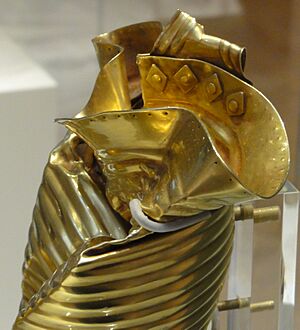Ringlemere Cup facts for kids
Quick facts for kids Ringlemere Cup |
|
|---|---|
 |
|
| Material | Gold |
| Created | 1700-1500 BC |
| Discovered | Ringlemere barrow in 2001 |
| Present location | British Museum |
The Ringlemere Gold Cup is a special cup from the Bronze Age. It was found in 2001 near a place called Ringlemere in Kent, England. This amazing cup is now kept at the British Museum.
What the Ringlemere Cup Looks Like
This gold cup was made by carefully hammering a single piece of gold. Its handle was cut from a flat gold strip and then attached with small metal pins called rivets. The cup was about 14 centimeters (about 5.5 inches) tall. It has cool wavy sides, like ripples.
Even though it was squashed a bit by farm plows, we can still see its original shape. It looks a bit like older clay cups from the late Neolithic period (around 2300 BC). These older cups often had patterns that looked like rope marks. But the Ringlemere Cup was made much later, during the Bronze Age.
Experts think this cup was not buried with someone who died. Instead, it was likely a votive offering. This means it was placed in the ground as a special gift to gods or spirits. It was put in the middle of a burial mound (a barrow) around 1700 to 1500 BC. No other burials from that time have been found right there. But later, people from the Iron Age and Anglo-Saxons did use the area for burials.
Only seven similar gold cups with round bottoms (which made them a bit wobbly) have been found in Europe. All of them date from 1700 to 1500 BC. The Ringlemere Cup is very much like another British cup, the Rillaton gold cup, found in Cornwall in 1837. Other similar cups have been found in Germany and Switzerland. This suggests that people traded these special cups across the English Channel.
How the Cup Was Found and Displayed
A person using a metal detector, Cliff Bradshaw, found the Ringlemere Cup on November 4, 2001. He reported his find, which is very important for old objects. Because of a law called the Treasure Act 1996, the cup was declared "treasure" in 2002.
The British Museum bought the cup for £270,000 (about $520,000 back then). This money was shared between Cliff Bradshaw and the family who owned the farm where it was found. Many groups helped raise the money, like the Heritage Lottery Fund. This made sure the cup could stay in Britain for everyone to see.
After the cup was found, archaeologists dug up the site between 2002 and 2005. They found signs of human activity from very old times, like the Mesolithic and Neolithic periods. They also found a burial area from the Early Bronze Age and an Anglo-Saxon cemetery.
The Ringlemere Cup was featured in a 2003 BBC Television show called Our Top Ten Treasures. It was number 10 on a list of important British archaeological finds. Cliff Bradshaw was even interviewed for the show.
The cup has been shown in many places. It was part of a special exhibition called "Buried Treasure" from 2004 to 2006. This exhibit traveled to different museums across Britain. After that, it was displayed at the British Museum with the Rillaton cup. It also went to Dover Museum for a while, which is closer to where it was found. Now, you can see the Ringlemere Cup in the Prehistory galleries at the British Museum.


